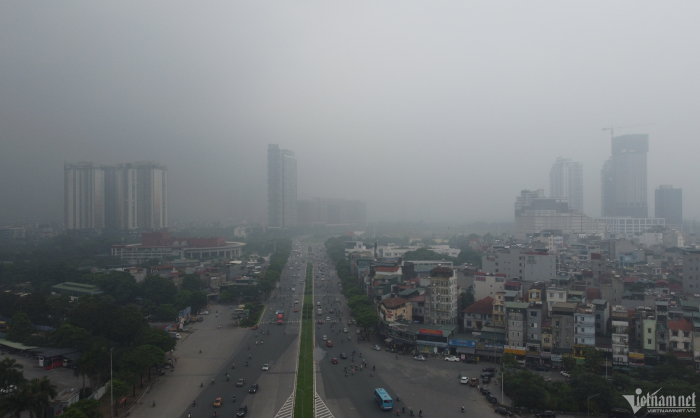
Drawing on effective models implemented in developed nations, Vietnam is learning valuable lessons - from policy frameworks to infrastructure solutions - to tackle air pollution.
Air pollution forecast and warning system underway
Air pollution remains a persistent public health concern across many countries, including Vietnam. In major cities such as Hanoi and Ho Chi Minh City, air quality has reached alarming levels.
According to Le Hoai Nam, Deputy Director General of the Department of Environment under the Ministry of Agriculture and Environment, the agency has implemented a range of urgent and long-term strategies to improve air quality.
In the short term, facing cyclical air pollution patterns, the Department of Environment has issued multiple directives urging local authorities to tighten emissions controls and address pollution hotspots during transitional weather periods.
A multi-model air pollution forecast and warning system is being developed for major cities, enabling short-term forecasts (24-48 hours). This system is currently in trial and will be officially launched once tested and refined.
The department is also finalizing guidelines for emergency measures in case of severe pollution and enhancing its automatic, continuous ambient air monitoring network. It is currently collaborating with Vingroup to install low-cost air quality sensors in Hanoi to expand the monitoring dataset.
In line with government directives, the department is drafting new national emission standards and a roadmap for managing vehicle emissions, targeting motorbikes, cars, and other transport sources.
A long-term regulatory framework
Beyond immediate measures, the department has laid out a robust legal framework including the 2020 Law on Environmental Protection and decrees such as Decree 08/2022/NĐ-CP and the amended Decree 05/2025/NĐ-CP. These regulations include standards for ambient air quality and industrial emissions.
The department has advised the Prime Minister on strategic directives such as Decision 1973/QD-TTg and Directive 03/CT-TTg to guide national air quality management from 2021 to 2025. A draft national action plan for 2025–2030 is in progress, outlining both urgent interventions and long-term strategies.
Despite clear laws, implementation at the local level faces significant barriers. These include a lack of synchronized monitoring infrastructure, insufficient professional capacity, and a shortage of financial resources. Currently, only 30 out of 63 provinces operate continuous, automatic air monitoring stations.
Local environmental officers, particularly at district and commune levels, often lack specialized training. In many areas, one official manages multiple environmental duties, limiting focus on air quality.
Investment in pollution reduction remains limited. Effective air quality improvements require substantial financial commitment, but budget constraints and inadequate funding mechanisms have hampered results. Additionally, Vietnam still lacks comprehensive emissions data, hindering evidence-based policy-making.
A fragmented approach across sectors - transport, construction, and industry - further complicates emissions control. Better interagency coordination and clearly defined responsibilities are urgently needed.
To turn legal mandates into action, Vietnam must:
Prioritize building a nationwide, integrated air monitoring network and ensure data sharing with the central government.
Strengthen local capacities through regular training, expert networks, and tailored policy support.
Allocate appropriate financial resources for critical programs and address local funding challenges.
Enforce strict emissions control for stationary, mobile, and diffuse sources with consistent inspections and accurate emissions inventories.
Execute practical air quality measures like street washing, dust suppression at construction sites, and restrictions on open burning.
Develop an interprovincial coordination mechanism for cross-regional air pollution management.
Encourage the media to rely on verified data from official air quality monitoring stations in public communication and forecasts.
Learning from international best practices
Countries like Japan, South Korea, and those in Europe have adopted effective air quality measures, including real-time monitoring and low-emission zones (LEZs). These zones restrict high-emission vehicles in city centers to reduce fine dust and toxic gases. Similarly, Asian cities have implemented real-time warning systems and promoted clean transportation.
Vietnam has started adopting similar models. The newly passed Capital Law includes Article 28, which lays the legal foundation for developing LEZs in Hanoi. The city’s People’s Council has issued Resolution 47/2024/NQ-HDND, designating pilot LEZs in districts such as Hoan Kiem and Ba Dinh, effective January 1, 2025. These zones are expected to build upon pedestrian areas already closed to motor traffic during weekends.
By creating LEZs, Hanoi aims to reduce pollution and promote green transportation options like electric buses, public bicycles, and urban rail.
Looking ahead, a national rollout of LEZs will require evaluating Hanoi’s pilot results to develop a scalable, effective roadmap for other cities.
nongnghiepmoitruong.vn